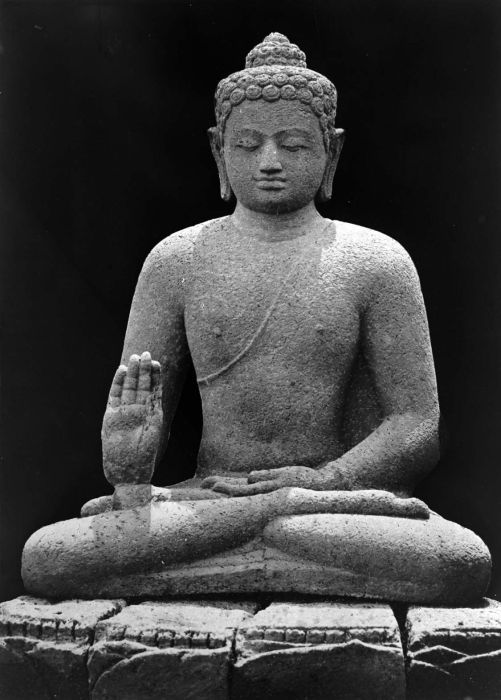
Candi Borobudur, Central Java, completed 825 CE.
Photograph attributed to Gunawan Kartapranata, Creative Commons Attribution-Share Alike 3.0 Unported license.
Images of the Buddha
On this page Pāḷi terms will be used, when describing the Buddha. The time of Buddha’s parinibbana has been calculated, based on the dates of the reign of the Emperor Ashoka, as 486 BCE. However, the actual date traditionally accepted as the date of the Buddha’s parinibbana in Theravāda countries is 544 or 545 BCE, because the reign was considered to be about 60 years earlier than current estimates. The first anthropomorphic representations of the Buddha started to emerge in the 1st century CE in Mathura, which followed Indian tradition. There were other examples in Gandhara, not long afterwards, which had been influenced by Greek culture since the formation of Indo-Greek kingdoms, following the conquests of Alexander the Great in 332 BCE. The art of both regions eventually coalesced. Before looking at more recent bronze Buddha images, it is interesting to look at one of the earliest examples from Mathura, dating from the first century BCE. This is probably the best example of how the Buddha might have appeared, before various changes took place in the iconography as witnessed in the one following from Gandhara. As an example of early Javanese Buddha images, a photograph of one of the many Buddha images from Borobudur is shown and also a remarkable standing Buddha statue from recent times. The numbered images are part of the Apsarah Gallery Collection.
Mathuran Buddha
 Material: red sandstone.
Material: red sandstone.
Posture: padmasana (lotus position), the right hand showing the abhayamudra (the mudra of dispelling fear), and the left hand the bhumisparshamudra, the mudra of pointing to the earth.
Seated on a throne, supported by lions, which is known as the simhasana.
The hair appears short, without curls and is drawn and formed into a small spiral top knot of hair, which is not an ushnisha[1]. The presence of the attendant bodhisattvas indicates that the Mahayana tradition had already begun at this time.
Note the simplicity of the throne, the thin fabric covering the Buddha and the amsumala (nimbus) behind the head.
Gandharan Buddha
 Material: schist.
Material: schist.
Posture: padmasana.
Seated on a simple throne with both hands showing the dhyanamudra, mudra of meditation, which is often found on an Amitabha Buddha image.
The hair is wavy and again drawn into a top knot, but whether this is covering an ushnisha is not clear. Again there are no curls.
Note the beautifully draped clothes, which show the influence from Classical Greek art and the amsumala (nimbus) behind the head.
Borobudur Seated Buddha
 Material: andesite stone
Material: andesite stone
Posture: padmasana
Seated on a vishvapadma or double lotus throne, with the right hand showing the abhayamudra, the mudra showing freedom from fear.
Note the tightly curled hair and the typically Javanese ushnisha.
This is the Amoghasiddi Buddha, which is one of the five Dhyani Buddhas at Borobudur and is located on the north face at the forth level.
1. Javanese Seated Buddha
 Material: bronze.
Material: bronze.
Patina: brownish-bronze
Posture: padmasana
Seated on a vishvapadma or double lotus throne on a rectangular socle with the right hand showing the abhayamudra, the mudra showing freedom from fear.
Note the tightly curled hair and the typically Javanese ushnisha.
The iconography is similar to the Amoghasiddhi Buddha statues at Borobudur.
From the type of workmanship the age is estimated at less than 100 years.
2. Javanese Standing Buddha
 Material: bronze.
Material: bronze.
Patina: brownish-green.
Posture: sampada on a vishvapadma or double lotus pedestal, with the right hand showing vitarkamudra, the mudra of teaching.
Note the tightly curled hair and the typically Javanese ushnisha. The ears are similar to those on the seated Buddha.
From the type of workmanship the age is estimated at less than 100 years.
3. Javanese Standing Buddha
Material: bronze.
Patina: brownish-green.
Posture: sampada on a vishvapadma (double lotus) pedestal, with the right hand showing the vitarkamudra, the mudra of teaching.
Note the tightly curled hair and the typically Javanese ushnisha. The ears are similar to those on the seated Buddha.
From the type of workmanship the age is estimated at less than 100 years.
4. Javanese Standing Buddha
 Material: bronze.
Material: bronze.
Patina: brownish-green.
Posture: sampada on a vishvapadma or double lotus pedestal, with the right hand showing the karanamudra or the mudra of dispelling evil, but possibly intended by the artisan to be the vitarkamudra, the mudra of teaching.
Note the tightly curled hair and the typically Javanese ushnisha. The ears are similar to those on the seated Buddha.
From the type of workmanship the age is estimated at less than 100 years.
Thai Standing Buddha at Phuttamonthon
 Material: bronze.
Material: bronze.
Patina: greyish-green.
Posture: abhanga (standing on the left foot with the right leg bent at the knee) on a lotus pedestal with the left hand showing the vitarkamudra, the teaching mudra.
Note the tightly curled hair and the ushnisha with a typical Thai flame ketumala.
From the photograph, the statue with the left arm raised appears to show the hand with the vitarkamudra. This mudra is usually performed with the right hand at chest level, although this gesture with the the arm raised can be seen in some regions such as Haripuñjaya2. Perhaps, because the left arm is raised, some references to this statue refer to it as the Halting the Sandalwood image mudra (see discussion of this in the following item), which should have an open hand like the abhayamudra, but the hand appears to show the vitarkamudra. More information should be available about this statute which was only made recently. This Buddha statue is located in Phutthamonthon Park (Thai: อุทยานพุทธมณฑล), which is a Buddhist park in the Phutthamonthon District, Nakhon Pathom Province, Thailand. The park was opened in 1957, which was the year 2500 in the Thai Buddhist Era. The statue, cast in 1981, is 15.87 m tall and is considered to be the tallest free-standing bronze Buddha statue in the world.
5. Javanese Standing Buddha
 Material: bronze.
Material: bronze.
Patina: brownish-green.
Posture: sampada (standing with feet together) on a vishvapadma or double lotus pedestal with the left hand showing a mudra similar to the abhayamudra, which is always made with the right hand.
Note the tightly curled hair and the ushnisha is rather larger than the typical Javanese one. The ears are similar to those on the seated Buddha.
At first the image may appear similar to the one above, but the left hand on the Phuttamonthon statue shows the vitarkamudra. The following one shows the abhayamudra, using the right hand, but the left hand is not used for this mudra. In a reference[2] about 19th century Bangkok, the mudra is said to have different meanings, depending on which hand is used; although one of the stories associated with this would seem to be apocryphal. Further research explained that this mudra showing an open hand with the left arm raised and the right arm pendant alongside the body was used by the Buddha to prevent an sandalwood image of him from rising in stories that are widely documented in Southeast Asia. In modern Thai iconography this mudra was codified as Halting the Sandalwood image.
From the type of workmanship the age is estimated at less than 100 years.
6. Javanese Standing Buddha
 Material: bronze.
Material: bronze.
Patina: brownish-green.
Posture: sampada on a simple 3-legged pedestal and with the right hand showing the abhayamudra, the mudra showing freedom from fear.
Note the lack of curly hair and ushnisha. There is an unusual ketumala or finial on the head, which might suggest Sri Lankan influence. The features of the face have a similarity to some figurines from the Majapahit period. See the Seated Female Ascetic on the Other Javanese Figurines page.
Although the provenance and age of this figurine is difficult to ascertain, it originated in East Java and, from the workmanship, it could be from the Majapahit period.
7. Bodh Gaya Seated Buddha
 Material: bronze, probably with zinc content.
Material: bronze, probably with zinc content.
Patina: yellowish-brown.
Posture: padmasana.
Seated on an ornate lotus throne, with the right hand showing the vitarkamudra and the left hand holding a patra in the shape of a medicine bowl.
Note the ushnisha, tightly curled hair and decorated robe.
The iconography indicates that this is Bhaisajya Buddha or the Medicine Buddha of Northern Buddhism or East Asian Buddhism. The right hand for the Medicine Buddha usually shows the varadamudra or the mudra of dispensing boons, also sometimes the abhayamudra.
This image originates from Bodh Gaya, India and the age is estimated at less than 50 years.
1. Ananda K. Coomaraswamy, The Origin of the Buddha Image, The Art Bulletin, vol. 9 No. 24 (June, 1927), p. 309.
2. Carrol Stratton, Buddhist Sculpture of Northern Thailand, Serindia Publications, Inc., 2004, p.43.
In the audio clip below, a part of the Theravada Buddhist tradition of recitation, in the presence of a bhikkhu, of the Vandana, or paying of homage to the Buddha; the Tisarana, or taking refuge in the Buddha, the Dhamma and the Sangha; and the Panca Sila, or Five Precepts to which Buddhist lay people adhere. The Theravada tradition uses the Pāḷi language.
